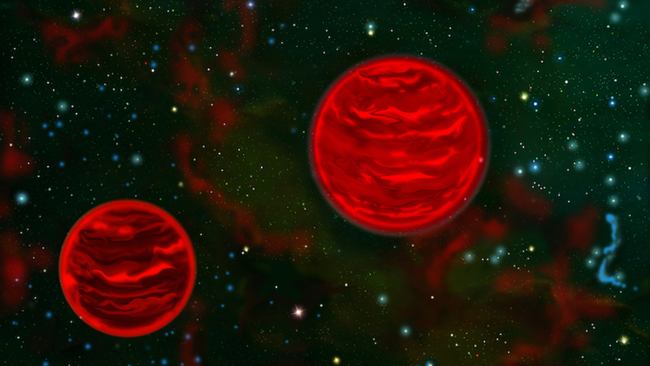Planetary mass binaries raise questions about the formation of intermediate mass objects
Last year, astronomers studying the Orion Nebula with the James Webb Space Telescope (JWST), discovered interesting planetary mass objects floating freely in this area. This discovery cast doubt on established ideas about the formation of planets and stars. Fresh research has added new depth to the mystery surrounding these objects, which are called JuMBO — Jupiter-mass binaries.
JuMBOs are neither stars nor planets. They were initially discovered by Mark McCaughreen, a senior scientific adviser to the European Space Agency (ESA), and his colleagues. These objects were spotted in the Orion Nebula, which is located approximately 1,350 light-years from Earth and is the birthplace of new stars.
To further study JuMBO, the researchers used data collected by the Very Large Array of 27 radio telescopes at the US National Radio Astronomy Observatory. Of all 40 detected JuMBOs, radio signals were detected from only one pair of objects.
The pair «JuMBO 24» is of particular interest. Researchers note that both objects in this pair have a mass exceeding the mass of the planet Jupiter by 11 times. This makes them the most massive objects of this type recorded by JWST. The mass of the remaining JuMBOs exceeds the mass of the most massive planet in the Solar System in the range from 3 to 8 times.
The observed JuMBO radio signals had significantly higher intensity compared to radio signals characteristic of brown dwarfs. Brown dwarfs — These are objects that had the potential to become stars, but did not gain enough mass to fuse hydrogen into helium in their cores, as happens with our Sun. Brown dwarfs typically have masses between 13 and 75 Jupiter masses.
JuMBOs are hot, gaseous, and relatively small objects that exist in pairs. This makes them unusual, since it has traditionally been assumed that only massive stars are most likely to exist in binary systems, rather than less powerful stellar bodies. About 75% of massive stars are in binary systems, with this percentage falling to 50% for stars the size of the Sun and 25% for the smallest stars. Therefore, the probability of detecting brown dwarfs in binary systems approaches zero. JuMBOs, which have a mass lower than that of brown dwarfs, should not exist in binary systems if they were formed precisely as stars.
But if JuMBOs are formed as stars, then the sheer number of them found in Orion suggests that the frequency of binary stellar objects for some reason increases significantly at masses below the masses of brown dwarfs. This cannot yet be taken into account in star formation models.
If planetary mass objects cannot be explained by existing models of star formation, then they may be born as planets. However, JuMBO pairs are difficult to explain if they formed as planets from leftover material in the disks left behind by their parent stars.
Some planets are known to be expelled from their parent star systems as a result of gravitational effects such as collisions with other star systems. As a result, they become «rogue planets» — objects devoid of a parent star, as well as JuMBO in the Orion Nebula. However, the process that produces these “rogue planets” must destroy gravitationally bound pairs of planets.
Researchers cannot yet explain why JuMBO ended up in pairs. What complicates efforts to explain is that some of these pairs are located at great distances from each other. For example, one pair of JuMBOs is located 300 times the distance between the Earth and the Sun. Other pairs are separated by the scale of the Solar System, indicating a weak gravitational connection between them.
Rodriguez and his colleagues were very familiar with Orion, having previously studied the nebula using the Virtual Radio Telescope (VLA). So, when JuMBOs appeared in JWST's infrared data, the team decided to look through archived radio wave observations to find radio wave counterparts for these objects.
“We took data from the VLA archive and calibrated it and found JuMBO in all three “epochs” data. We detected radio wave emissions from the most massive JuMBO binary, but it is unclear why the others were not detected in radio wave observations», — Rodriguez said.
The team believes that other JuMBOs may also emit radio waves because their components are smaller than the two 11-Jupiter mass objects in the binary system JuMBO 24. Scientists hope to deepen their knowledge of JuMBOs through deeper models and further observations . One hypothesis suggests that JuMBOs move quickly, which may indicate their formation as planets around stars and subsequent ejection from the system. Alternatively, JuMBOs may be formed from massive clouds of gas and dust, similar to stars. Any explanation will prompt a rethinking of how stars and planets form and evolve in their systems.
Rodriguez refutes suggestions that radio signals from JuMBO 24 indicate signs of life. He notes that it is possible that if JuMBO had satellites, life in their subsurface oceans could exist similar to that proposed on Europa, Ganymede and Enceladus. However, due to JuMBO's youth (only a few million years old compared to Earth's 4.6 billion years), the likelihood of life developing is now low.
Scientists continue to study JuMBOs and their characteristics to further our understanding of planet formation and evolution. However, JuMBOs are not promising candidates for the search for life outside the Solar System.
So while JuMBOs may be an astronomical discovery of the 2020s and interesting targets for scientists who want to better understand the formation of stars and planets, they may not be targets for the search for life beyond the solar system.

